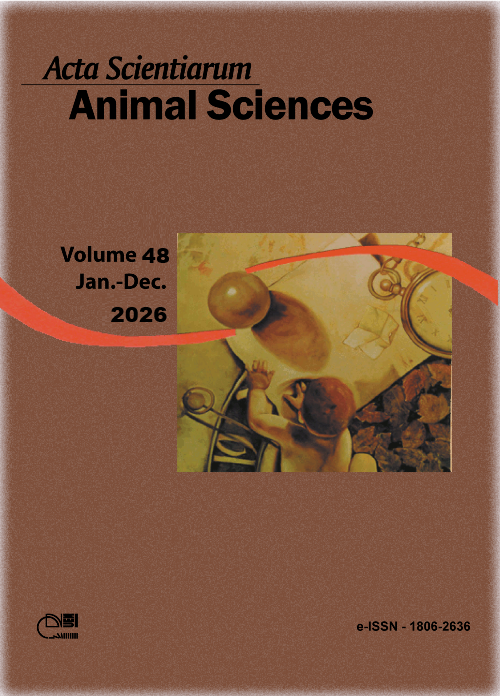Ruminal metabolism, blood parameters and animal behavior of bulls submitted to sub-acute ruminal acidosis (SARA) receiving different buffers in high-concentrate diets
Abstract
This study aimed to evaluate the supplementation of four different buffers into a high-grain diet on ruminal fermentation, blood metabolites, and feeding behavior of feedlot cattle. Five rumen-cannulated bulls (492 ± 24 kg) were distributed in a 5 x 5 Latin square design, through the treatments: CONT (no buffer), RUMO, RUMF, BICA and ALGA. The buffers did not alter (p > 0.05) the apparent digestibility of nutrients, ruminal fluid pH, volatile fatty acid profile, and acetic/propionic ratio compared to the CONT. Except for propionic and isovaleric acids, which were different (p < 0.05) among treatments at 4 and zero hours after feeding, respectively. Ruminal lactic acid accumulation was greater (p < 0.05) in BICA, while ammoniacal nitrogen concentrations were highest (p < 0.05) in CONT and lowest in RUMF. Blood glucose and creatinine were unaffected (p > 0.05), whereas urea and lactate concentrations were reduced (p < 0.05) in RUMO. Among the enzymes, only gamma-glutamyl transferase and creatine kinase showed treatment effects (p < 0.05). Furthermore, feeding and drinking times were unaffected by treatments; however, rumination increased (p < 0.05) in BICA, and idleness was higher in CONT. Overall, buffer inclusion modified ruminal and metabolic responses, indicating a possible modulation of ruminal acidosis.
Downloads
References
Abdela, N. (2016). Sub-acute ruminal acidosis (SARA) and its consequence in dairy cattle: a review of past and recent research at global prospective. Achievements in the Life Sciences, 10(2), 187-196. https://doi.org/10.1016/j.als.2016.11.006
Almeida, F., Schiavo, L. V., Vieira, A. D., Araújo, G. L., Queiroz-Junior, C. M., Teixeira, M. M., Cassali, G. D., & Tagliati, C. A. (2012). Gastroprotective and toxicological evaluation of the Lithothamnion calcareum algae. Food and Chemical Toxicology, 50(5), 1399-1404. https://doi.org/10.1016/j.fct.2012.02.028
Association of Officiating Analytical Chemists. (2005). Official method of Analysis. Association of Officiating Analytical Chemists.
Arik, H. D., Gulsen, N., Hayirli, A., & Alatas, M. S. (2019). Efficacy of Megasphaera elsdenii inoculation in subacute ruminal acidosis in cattle. Journal of Animal Physiology and Animal Nutrition, 103(2), 416-426. https://doi.org/10.1111/jpn.13034
Bailey, C. B. (1961). Saliva secretion and its relation to feeding in cattle. British Journal of Nutrition, 15(4), 489-498. https://doi.org/10.1079/bjn19610062
Beauchemin, K. A., Yang, W. Z., & Rode, L. M. (2003). Effects of particle size of alfalfa-based dairy cow diets on chewing activity, ruminal fermentation, and milk production. Journal of Dairy Science, 86(2), 630-643. https://doi.org/10.3168/jds.S0022-0302(03)73641-8.
Boeckaert, C., Vlaeminck, B., Dijkstra, J., Issa-Zacharia, A., Van Nespen, T., Van Straalen, W., & Fievez, V. (2008). Effect of dietary starch or micro algae supplementation on rumen fermentation and milk fatty acid composition of dairy cows. Journal of Dairy Science, 91(12), 4714-4727. https://doi.org/http://dx.doi.org/10.3168/jds.2008-1178
Bürger, P. J., Pereira, J. C., Queiroz, A. C., Coelho, J. F., Valadares Filho, S. C., Cecon, P. R., Casali, A. D. P. (2000). Comportamento ingestivo de bezerros holandeses alimentados com dietas contendo diferentes níveis de concentrado. Revista Brasileira de Zootecnia, 29(1), 236-242. https://doi.org/http://dx.doi.org/10.1590/S1516-35982000000100031
Callaway, E. S., & Martin, S. A. (1997). Effects of a Saccharomyces cerevisiae culture on ruminal bacteria that utilize lactate and digest cellulose. Journal of Dairy Science, 80(9), 2035-2044. https://doi.org/10.3168/jds.S0022-0302(97)76148-4
Calsamiglia, S., Ferret, A., & Devant, M. (2002). Effects of pH and pH fluctuations on microbial fermentation and nutrient flow from a dual-flow continuous culture system. Journal of Dairy Science, 85(3), 574-579. https://doi.org/10.3168/jds.S0022-0302(02)74111-8
Carvalho, V. M., Ávila, V. A. D., Bonin, E., Matos, A. M., Prado, R. M., Castilho, R. C., Silva, R. R., Abreu Filho, B. A., & Prado, I. N. (2021). Effect of extract from baccharis, tamarind, cashew nut shell liquid and clove on animal performance, feed efficiency, digestibility, rumen fermentation and feeding behavior of bulls finished in feedlot. Livestock Science, 244, 104361. https://doi.org/10.1016/j.livsci.2020.104361
Carvalho, R. F., Mazon, M. R., Silva, A. P. S., Oliveira, L. S., Zotti, C. A., Silva, S. L., & Leme, P. R. (2016). Use of calcareous algae and monensin in Nellore cattle subjected to an abrupt change in diet. Ciência Rural, 46(4), 713-718. https://doi.org/10.1590/0103-8478cr20150278
Chaney, A. L., & Marbach, E. P. (1962). Modified reagents for determination of urea and ammonia. Clinical Chemistry, 8(2), 130-132. https://doi.org/10.1093/clinchem/8.2.130
Cruywagen, C. W., Taylor, S, Beya, M. M., & Calitz, T. (2015.The effect of buffering dairy cow diets with limestone, calcareous marine algae, or sodium bicarbonate on ruminal pH profiles, production responses, and rumen fermentation. Journal of Dairy Science, 98(8), 5506-5514. https://doi.org/10.3168/jds.2014-8875
Cruz, O. T. B., Valero, M. V., Zawadzki, F., Rivaroli, D. C., Prado, R. M., Lima, B. S., & Prado, I. N. (2014). Effect of glycerine and essential oils (Anacardium occidentale and Ricinus communis) on animal performance, feed efficiency and carcass characteristics of crossbred bulls finished in a feedlot system. Italian Journal of Animal Science, 13(4), 3492. https://doi.org/10.4081/ijas.2014.3492
Erdman, R. A. (1988). Dietary buffering requirements of the lactating dairy cow: a review. Journal of Dairy Science, 71(12), 3246-3266. https://doi.org/10.3168/jds.S0022-0302(88)79930-0
Fregadolli, F. L., Zeoula, L. M., Branco, A. F., Prado, I. N., Caldas Neto, S. F., Guimarães, K. C., Kassies, M. P., & Dalponte, A. O. (2001). Efeitos das fontes de amido e nitrogênio de diferentes degradabilidades ruminais. 2. pH, concentração de amônia no líquido ruminal e eficiência de síntese microbiana. Revista Brasileira de Zootecnia, 30(3), 870-879. https://doi.org/10.1590/S1516-35982001000300036
Gastaldello Júnior, A. L., Pires, A. V., Susin, I., Mendes, C. Q., Queiroz, M. A. A., Amaral, R. C., Gentil, R. S., Ferreira, E. M., Mourão, G B., & Eastridge, M. L. (2013). Limestone with different particle size and sodium bicarbonate to feedlot lambs fed high grain diets with or without monensin. Small Ruminant Research, 114(1), 80-85. https://doi.org/10.1016/j.smallrumres.2013.05.009
González, L. A., Manteca, X., Calsamiglia, S., Schwartzkopf-Genswein, K. S., & Ferret, A. (2012). Ruminal acidosis in feedlot cattle: Interplay between feed ingredients, rumen function and feeding behavior (a review). Animal Feed Science and Technology, 172(1-2), 66-79. https://doi.org/10.1016/j.anifeedsci.2011.12.009
Gozho, G. N., Krause, D. O., & Plaizier, J. C. (2007). Ruminal lipopolysaccharide concentration and inflammatory response during grain-induced subacute ruminal acidosis in dairy cows. Journal of Dairy Science, 90(2), 856-866. https://doi.org/10.3168/jds.S0022-0302(07)71569-2
Han, G., Gao, X., Duan, J., Zhang, H., Zheng, Y., He, J., Huo, N., Pei, Li, H., & Gu, S. (2021). Effects of yeasts on rumen bacterial flora, abnormal metabolites, and blood gas in sheep with induced subacute ruminal acidosis. Animal Feed Science and Technology, 280, 115042. https://doi.org/10.1016/j.anifeedsci.2021.115042
Hernández, J., Benedito, J. L., Abuelo, A., & Castillo, C. (2014). Ruminal acidosis in feedlot: from aetiology to prevention. The Scientific World Journal, 2014, 702572. https://doi.org/10.1155/2014/702572
Herod, E. L., Bechtle, R. M., Bartley, E. E., & Dayton, A. D. (1978). Buffering ability of several compounds in vitro and the effect of a selected buffer combination on ruminal acid production in vivo. Journal of Dairy Science, 61(8), 1114-1122. https://doi.org/10.3168/jds.S0022-0302(78)83695-9
Huhtanen, P., Kaustell, K., & Jaakkola, S. (1994). The use of internal markers to predict total digestibility and duodenal flow of nutrients in cattle given six different diets. Animal Feed Science and Technology, 48(3-4), 211-227. https://doi.org/10.1016/0377-8401(94)90173-2
Iwaniuk, M. E., & Erdman, R. A. (2015). Intake, milk production, ruminal, and feed efficiency responses to dietary cation-anion difference by lactating dairy cows. Journal of Dairy Science, 98(12), 8973-8985. https://doi.org/10.3168/jds.2015-9949
Jain, N. C., & Jain, A. H. (1993). Essentials of veterinary hematology. Wiley-Blackwell.
Jaramillo-López, E., Itza-Ortiz, M. F., Peraza-Mercado, G., & Carrera-Chávez, J. M. (2017). Ruminal acidosis: strategies for its control. Austral Journal of Veterinary Sciences, 49(3), 139-148. https://doi.org/10.4067/S0719-81322017000300139
Khalouei, H., Seranatne, V., Fehr, K., Guo, J., Yoon, I., Khafipour, E., & Plaizier, J. C. (2021). Effects of Saccharomyces cerevisiae fermentation products and subacute ruminal acidosis on feed intake, fermentation, and nutrient digestibilities in lactating dairy cows. Canadian Journal of Animal Science, 101(1), 143-157. https://doi.org/10.1139/cjas-2020-0018
Kozloski, G. V. (2011). Bioquímica dos ruminantes. Editora Universidade Federal de Santa Maria.
Kramer, J. W. (2000). Normal hematology of cattle, sheep and goats. In B. F. Feldman, J. G. Zinkl, & N. C. Jain (Eds.), Schalm’s veterinary hematology (pp. 1075-1084). Lippincott Williams and Wilkins.
Maeda, E. M., Zeoula, L. M., Juliano, L., Geron, V., Best, J., Prado, I. N., Martins, E. N., & Kazama, R. (2007). Digestibilidade e características ruminais de dietas com diferentes níveis de concentrado para bubalinos e bovinos Digestibility and ruminal metabolism on bubalines and bovines fed diets with different concentrate levels. Revista Brasileira de Zootecnia, 36(3), 716-726. https://doi.org/10.1590/S1516-35982007000300027
Matos, A. M., Duarte, V., Tagiariolli, M., Bonin, E., Vital, A. C. P., Guerrero, A., Prado, R. M., Costa e Silva, L. F., Ávila, V. D., Carvalho, V. M., & Prado, I. N. (2023). Meat acceptability of crossbred bulls fed a high-grain feedlot diet with antimicrobial compounds and a blend of organic trace minerals and yeast. Animal Production Science, 63(1), 85-95. https://doi.org/10.1071/AN22092
Mertens, D. R. (2002). Gravimetric determination of amylase-treated neutral detergent fiber in feeds with refluxing in beakers or crucibles: collaborative study. Journal of AOAC International, 85(6), 1217-1240.
Minami, N. S., Sousa, R. S., Oliveira, F. L. C., Dias, M. R. B., Cassiano, D. A., Mori, C. S., Minervino, A. H. H., & Ortolani, E. L. (2021). Subacute ruminal acidosis in Zebu cattle: Clinical and behavioral aspects. Animals, 11(1), 21. https://doi.org/10.3390/ani11010021
Mottin, C., Catalano, F. A. R., Chefer, D. M., Araújo, F. L., Carvalho, V. M., Guerrero, A., Ornaghi, M. G., Souza, K. A., Castilho, R. A., & Prado, I. N. (2020). Effect of essential and vegetable oil blend supplementation on animal performance, feed intake, rumen fermentation and rumen microbial populations of crossbred steers finished in a pasture system. Research, Society and Development, 9(9), 1-20. https://doi.org/10.33448/rsd-v9i9.8057
Nagaraja, T. G., & Titgemeyer, E. C. (2007). Ruminal acidosis in beef cattle: the current microbiological and nutritional outlook. Journal of Dairy Science, 90(Suppl), E17-E38. https://doi.org/10.3168/jds.2006-478
Neville, E. W., Fahey, A. G, Gath, V. P., Molloy, B. P., Taylor, S. J., & Mulligan, F. J. (2019). The effect of calcareous marine algae, with or without marine magnesium oxide, and sodium bicarbonate on rumen pH and milk production in mid-lactation dairy cows. Journal of Dairy Science, 102(9), 8027-8039. https://doi.org/10.3168/jds.2019-16244
Nielsen, B. L. (1999). On the interpretation of feeding behaviour measures and the use of feeding rate as an indicator of social constraint. Applied Animal Behaviour Science, 63(1), 79-91. https://doi.org/10.1016/S0168-1591(99)00003-9
Ornaghi, M. G., Passetti, R. A. C., Torrecilhas, J. A., Mottin, C., Vital, A. P., Guerrero, A., Sañudo, C., Campo, M. M., & Prado, I. N. (2017). Essential oils in the diet of young bulls: effect on animal performance, digestibility, temperament, feeding behaviour and carcass characteristics. Animal Feed Science and Technology, 234, 274-283. https://doi.org/10.1016/j.anifeedsci.2017.10.008
Owens, F. N., Secrist, D. S., Hill, W. J., & Gill, D. R. (1998). Acidosis in cattle: a review. Journal of Animal Science, 76(1), 275-286. https://doi.org/10.2527/1998.761275x
Plaizier, J. C., Li, S., Tun, H. M., & Khafipour, E. (2017). Nutritional models of experimentally-induced subacute ruminal acidosis (SARA) differ in their impact on rumen and hindgut bacterial communities in dairy cows. Frontiers in Microbiology, 7, 2128. https://doi.org/10.3389/fmicb.2016.02128
Plaizier, J. C., Mesgaran, M. D., Derakhshani, H., Golder, H., Khafipour, E., Kleen, J. L., Lean, I., Loor, J., Penner, G., & Zebeli, Q. (2018). Review: enhancing gastrointestinal health in dairy cows. Animal, 12(suppl 2), s399-s418. https://doi.org/10.1017/S1751731118001921
Prado, O. P. P., Zeoula, L. M., Moura, L. P. P., Franco, S. L., Prado, I. N., & Gomes, H. C. C. (2010). Digestibilidade e parâmetros ruminais de dietas à base de forragem com adição de própolis e monensina sódica para bovinos. Revista Brasileira de Zootecnia, 39(6), 1336-1345. https://doi.org/10.1590/S1516-35982010000600024
Pryce, J. D. (1969). A modificacion of the Barker-Summerson method for the determination of lactic acid. Analyst, 94(1125), 1151-1152.
Quinn, L. Y., Burroughs, W., & Christiansen, W. C. (1962). Continuous culture of ruminal microorganisms in chemically defined medium: II. Culture medium studies. Applied Microbiology, 10(6), 583-592. https://doi.org/10.1128/am.10.6.583-592.1962
Rivaroli, D. C., Campo, M. M., Sañudo, C., Guerrero, A., Jorge, A. M., Vital, A. C. P., Valero, M. V., Prado, R. M., & Prado, I. N. (2020). Effect of an essential oils blend on meat characteristics of crossbred heifers finished on a high-grain diet in a feedlot. Animal Production Science, 60(4), 595-602. https://doi.org/10.1071/AN18620
Sharma, H., Pal, R. P., Mir, S. H., Mani, V., & Ojha, L. (2018). Effect of feeding buffer on feed intake, milk production and rumen fermentation pattern in lactating animals: a review. Journal of Entomology and Zoology Studies, 6(4), 916-922.
Silva, R. R., Silva, F. F., Prado, I. N., Carvalho, G. G. P., Franco, I. L., Almeida, V. S., Cardoso, C. P., & Ribeiro, M. H. S. (2006). Comportamento ingestivo de bovinos. Aspectos metodológicos. Archivos de Zootecnia, 55(211), 293-296.
Soto, E. C., Molina-Alcaide, E., Khelil, H., & Yáñez-Ruiz, D. R. (2013). Ruminal microbiota developing in different in vitro simulation systems inoculated with goats’ rumen liquor. Animal Feed Science and Technology, 185(1-2), 9-18. https://doi.org/http://dx.doi.org/10.1016/j.anifeedsci.2013.06.003
Souza, K., Monteschio, J. O., Mottin, C., Ramos, T., Pinto, L. A. M., Eiras, C. E., Guerrero, A., & Prado, I. N. (2019). Effects of diet supplementation with clove and rosemary essential oils and protected oils (eugenol, thymol and vanillin) on animal performance, carcass characteristics, digestibility, and ingestive behavior activities for Nellore heifers finished in feedl. Livestock Science, 220, 190-195. https://doi.org/10.1016/j.livsci.2018.12.026
Torrecilhas, J. A., Ornaghi, M. G., Passetti, R. A. C., Mottin, C., Guerrero, A., Ramos, T. R., Vital, A. C. P., Sañudo, C., Malheiros, E. B., & Prado, I. N. (2021). Meat quality of young bulls finished in a feedlot and supplemented with clove or cinnamon essential oils. Meat Science, 174, 108412. https://doi.org/10.1016/j.meatsci.2020.108412
Valente, T. N. P., Sampaio, C. B., Lima, E. D. S., Deminicis, B. B., Cezário, A. S., & Santos, W. (2017). Aspects of acidosis in ruminants with a focus on nutrition: a review. Journal of Agricultural Science, 9(3), 90-97.
Del Valle, T. A., Antonio, G., Zenatti, T. F., Campana, M., Zilio, E. M. C., Ghizzi, L. G., Gandra, J. R., Osório, J. A. C., & Morais, J. P. G. (2018). Effects of xylanase on the fermentation profile and chemical composition of sugarcane silage. The Journal of Agricultural Science, 156(9), 1123-1129. https://doi.org/10.1017/S0021859618001090.
Vyas, D., Uwizeye, A., Mohammed, R., Yang, W. Z., Walker, N. D., & Beauchemin, K. A. (2014). The effects of active dried and killed dried yeast on subacute ruminal acidosis, ruminal fermentation, and nutrient digestibility in beef heifers. Journal of Animal Science, 92(2), 724-732. https://doi.org/10.2527/jas.2013-7072
Watanabe, Y., Kim, Y-H., Kushibiki, S., Ikuta, K., Ichijo, T., & Sato, S. (2019). Effects of active dried Saccharomyces cerevisiae on ruminal fermentation and bacterial community during the short-term ruminal acidosis challenge model in Holstein calves. Journal of Dairy Science, 102(7), 6518-6531. https://doi.org/10.3168/jds.2018-15871.
Xu, C., Shen, T., Yang, W., Yu, H., Gao, S., & Huang, B. (2016). The effect of subacute ruminal acidosis of dairy cows on productivity, digestibility and greenhouse gas emission. Journal of Agricultural Science, 8(4), 92. https://doi.org/10.5539/jas.v8n4p92.
Copyright (c) 2026 Tatiane Rogélio Ramos, Kennyson Alves de Souza, Rodolpho Martin do Prado, Mariana Garcia Ornaghi, Osmair Flávio Stuani, Jaísa Casetta, Janaína Macieira Bragatto, Ivanor Nunes do Prado

This work is licensed under a Creative Commons Attribution 4.0 International License.
DECLARATION OF ORIGINALITY AND COPYRIGHTS
- I Declare that current article is original and has not been submitted for publication, in part or in whole, to any other national or international journal.
The copyrights belong exclusively to the authors. Published content is licensed under Creative Commons Attribution 4.0 (CC BY 4.0) guidelines, which allows sharing (copy and distribution of the material in any medium or format) and adaptation (remix, transform, and build upon the material) for any purpose, even commercially, under the terms of attribution.
Read this link for further information on how to use CC BY 4.0 properly.








































